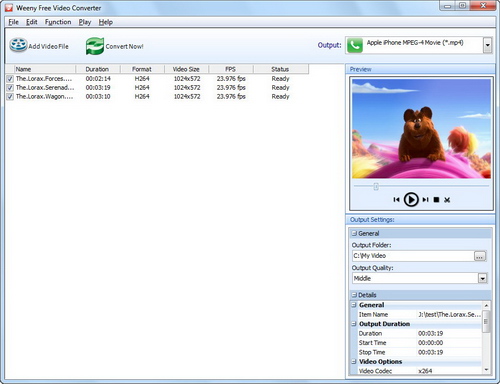Free Video Converter is a free video converter software to convert video files between many formats with ease. It can convert video files from 3gp, asf, avi, flv, mp4, mpg, rm, rmvb, vob, wmv and more into 3gp, avi, flv, mp4, mpg or wmv files.
Convert Video Formats: AVI, FLV, MPEG, QuickTime, RM, WMV
AVI
(DivX, XviD, MS MPEG-4, Uncompressed, Cinepak and other) AVI stands for Audio Video Interleave. It is a special case of the RIFF (Resource Interchange File Format). AVI is defined by Microsoft. AVI is the most common format for audio/video data on the PC. AVI is an example of a de facto (by fact) standard.
AVI Files are a special case of RIFF files. RIFF is the Resource Interchange File Format. This is a general purpose format for exchanging multimedia data types that was defined by Microsoft and IBM during their long forgotten alliance. FLV FLV is the preferred file format for delivering video clips via Flash. It is a specialized file format that has been supported from version 7.
Binary file format that delivers "bitmapped" video, limited to one video and one audio stream per file, over the Internet to one or another versions of the Macromedia Flash Player.
FLV
Flash Video is a container file format used to deliver video over the Internet using Adobe Flash Player versions 6–10. Flash Video content may also be embedded within SWF files. There are two different video file formats known as Flash Video: FLV and F4V. The audio and video data within FLV files are encoded in the same way as they are within SWF files. Both formats are supported in Adobe Flash Player and currently developed by Adobe Systems.
Flash Video has been accepted as the default online video format by many sites. Notable users of it include YouTube, Hulu, VEVO, Yahoo! Video, metacafe, Reuters.com, and many other news providers.
Flash Video is viewable on most operating systems except iOS, via the Adobe Flash Player and web browser plugin or one of several third-party programs.
MPEG
files provide excellent picture quality but can be very slow to decompress. For this reason, many MPEG decoding systems are hardware-assisted, meaning that you need a board to play MPEG files reliably without dropping a lot of frames. Although software decoders definitely exist (and there are some very good ones out there), they tend to require a lot of processor power on your system and also usually support MPEG video only (they have no soundtrack).
A third drawback of MPEG video as a standard for the Web is that MPEG movies are very expensive to encode. You need a hardware encoder to do so, and the price ranges for encoders are in the thousands of dollars. As MPEG becomes more popular, those prices are likely to drop. But for now, unless you already have access to the encoding equipment or you're really serious about your digital video, a software-based format is probably the better way to go.
QuickTime
supports many different codecs, particularly CinePak and Indeo, both of which can be used cross-platform.
RM
Real Networks Video. It is a streaming media format known as RealMedia with the file extension .rm using RealAudio audio compression and RealVideo video compression (RealVideo, also known as ClearVideo, is Iterated Systems fractal video compression). Quick Time Apple video format for the Macintosh. Although QuickTime was developed by Apple for the Macintosh, QuickTime files are the closest thing the Web has to a standard cross-platform movie format (with MPEG a close second). The Apple system software includes QuickTime and a simple player (called MoviePlayer or SimplePlayer). For PCs, QuickTime files can be played through the QuickTime for Windows (QTfW) package, and the freely available Xanim program will play them under the X Window System and UNIX. QuickTime movies have the extension .qt or .mov.
WMV
Windows Media Video. Formerly known as .ASF file format from Microsoft. A .WMV file includes a video stream (compressed using MS MPEG4 or WMV1 codec) combined with WMA encoded audio stream. The file format is proprietary and backward incompatible. Currently, dedicated to slow dialup connections, this media format does not allow even sub-VHS video quality due to blurred picture. WMA audio quality, compared to MPEG Layer3 of the same bitrate, isn't better either. You may wish to use Windows Media format to create smallest files that are suitable to send by e-mail, however you must keep in mind that .WMV file works like "one way ticket" - once created, it can't be edited anymore, without horrific quality loss. As opposite, AVI files compressed with MPEG4 video codec are still editable and often it is possible to retain source video quality.
Screenshot:
